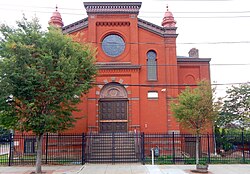Oheb Shalom Congregation (transliterated from Hebrew as 'Lovers of Peace') is an egalitarian,[clarification needed] Conservative Jewish congregation and synagogue located in South Orange, Essex County, New Jersey, in the United States.[2] The synagogue is affiliated with the United Synagogue of Conservative Judaism.
| Oheb Shalom Congregation | |
|---|---|
| Religion | |
| Affiliation | Conservative Judaism |
| Ecclesiastical or organizational status | Synagogue |
| Leadership | Rabbi Abigail Treu |
| Status | Active |
| Location | |
| Location | 170 Scotland Road, South Orange, Essex County, New Jersey |
| Country | United States |
Location in Essex County, New Jersey | |
| Administration | United Synagogue of Conservative Judaism |
| Geographic coordinates | 40°44′55″N 74°15′18″W / 40.7486°N 74.2551°W |
| Architecture | |
| Date established | 1860 (as a congregation) |
| Completed |
|
| Website | |
| ohebshalom | |
Prince Street Synagogue | |
 Former Prince Street Synagogue, in 2018 | |
| Location | 32 Prince Street, Springfield/Belmont, Newark, Essex County, New Jersey |
| Coordinates | 40°44′10″N 74°11′07″W / 40.73612°N 74.185393°W |
| NJRHP No. | 1299 |
| Designated NJRHP | January 16, 1990 |
| [1] | |
Its historic former synagogue building, built in 1884, located on Price Street, is one the oldest synagogues in the United States and was listed on the New Jersey Register of Historic Places in 1990.
History
editThe congregation was founded in Newark in September 1860 by a group of Bohemian Jews, the congregation's members have lived in and served Essex County and the broader community for over 160 years.[citation needed]
The modest Moorish Revival building at 32 Prince Street in the Springfield/Belmont neighborhood was built in 1884.[3][4][5] It is one of the oldest synagogues in the United States.[6][7]
Documentation records[citation needed] note Prince Street in Newark as a being one of the earliest, relatively clandestine places of Jewish settlement and worship (primarily Sephardic Jews of Spanish, Portuguese, or Italian descent) in the colonial and early American eras. The later arriving Ashkenazi Jews of Newark accommodated to the areas in and around Prince Street, named for one of the original anglicized Sephardic family names.[citation needed]
In 1911, the congregation moved to High Street (later renamed Dr. Martin Luther King, Jr. Blvd.) and subsequently relocated to Scotland Road in South Orange in 1958.[8]
The Prince Street building served as the home of the Metropolitan Baptist Church from 1940 to 1993. In 1990 it was slated for destruction as part of land clearance to enable the construction of Newark's Society Hill housing development. Mark W. Gordon, a historic preservationis, led a movement to preserve the historic building.[4][9]
It was restored by Greater Newark Conservancy and is now used as an environmental center.[10] It was listed on the New Jersey Register of Historic Places on January 16, 1990.[1][3] The brick synagogue features windows with Horseshoe arches, an entrance arch with red and white Voussoirs, and twin towers topped by modest domes.
The rabbi, since July 2021, is Rabbi Abigail Treu; and the cantor is Eliana Kissner.
See also
editReferences
edit- ^ a b "New Jersey and National Registers of Historic Places – Essex County" (PDF). New Jersey Department of Environmental Protection – Historic Preservation Office. September 29, 2022. p. 21.
listed as the Oheb Shalom Synagogue (Metropolitan Baptist Church) (ID#1299)
- ^ Welk, Naoma (2002). South Orange. Arcadia Publishing. p. 118.
- ^ a b A History of the City of Newark, New Jersey. New York & Chicago: Lewis Historical Publishing Col. 1913.
- ^ a b Gordon, Mark W. (1996). "Rediscovering Jewish Infrastructure: Update on United States Nineteenth Century Synagogues". American Jewish History. 84 (1) (2019 update ed.): 11–27.
- ^ "POSTINGS: Razing or Reuse?; Sanctuary's Fate In the Balance". The New York Times. May 30, 1993. ISSN 0362-4331. Retrieved February 22, 2018.
- ^ "Congregation Oheb-Shalom". Archived from the original on October 20, 2007.
- ^ Greenagel, Frank L. (2001). The New Jersey Churchscape: Encountering Eighteenth and Nineteenth Century Churches. Rutgers University Press. p. 93.
- ^ "Our history". Oheb Shalom Congregation. 2018. Retrieved February 22, 2018.[self-published source?]
- ^ "Sanctuary's Fate in the Balance". The New York Times. May 30, 1993.
- ^ "July". New Jersey Churchscape.
External links
edit- Official website
- "Synagogue images". Virtual Newark, New Jersey. Archived from the original on March 22, 2006.
- Oheb Shalom Cemetery website
